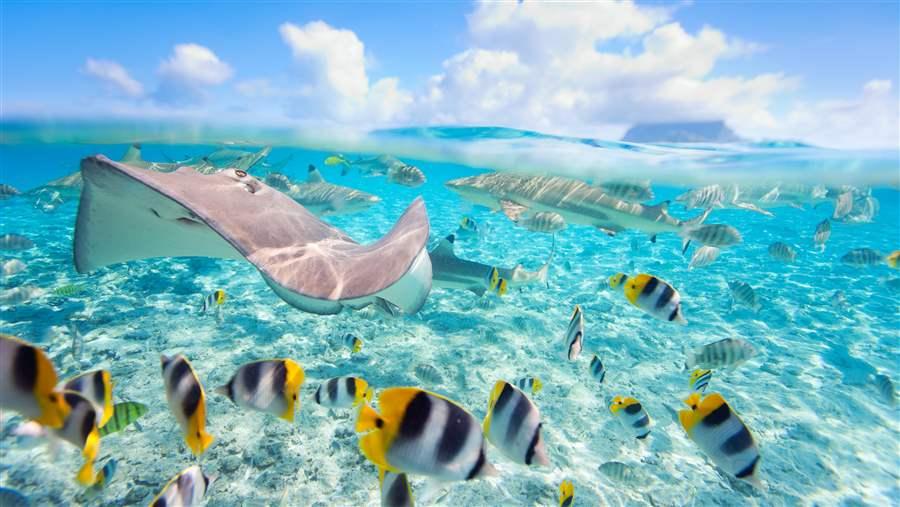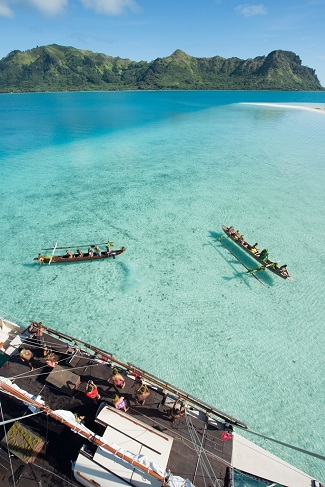Pacific Voyagers Connect People and the Ocean for Conservation
Expedition to Austral Islands also helps revive ancient navigation methods

The southernmost islands in French Polynesia, the Australs, are home to 14 species of sharks and four species of rays.
© ShutterstockAfter four days at sea and amid a violent storm, our voyaging canoe finally approached Raivavae, a Pacific island about 445 miles south of Tahiti. As thick rain and waves lashed the deck, I fought to keep the boat on course during a shift at the helm. As happy as I was to see land, I was also already growing nostalgic about leaving the great ocean.
This crossing from Tahiti, part of a 20-day spring expedition on board the Fa’afaite, a 22-metre (72-foot) double-hulled traditional Polynesian pirogue, gave me a taste of what the great Polynesian wayfinders must have felt as they plied these waters for almost 3,000 years. They explored thousands of Pacific islands navigating by the stars, sun, flight path of seabirds, ocean currents, salinity, and instinct.
The Australs are the southernmost islands in French Polynesia, and we were here on a trip led by the Tahiti Voyaging Society to help revive the practice of traditional navigation and promote ocean conservation. In particular, the Fa’afaite canoe was visiting four islands in support of a large marine reserve proposed by Austral Island leaders. The Rāhui Nui No Tuha’a Pae, or the great rāhui (protected area) of the Australs, would include a 20-nautical-mile coastal fishing area around each island for locals and a large, strictly protected zone of 1 million square kilometres (about 386,000 square miles) offshore.
Capt. Titaua Teipoarii hosted on board a crew of local leaders, fishermen, journalists, scientists, my colleague Donatien Tanret, and me. As part of the Pew Bertarelli Ocean Legacy Project, and the Global Ocean Legacy campaign before it, Pew has worked with local communities in French Polynesia for years to help protect this region’s extraordinary marine environment.
Warm welcomes on distant shores
When we finally came ashore in Raivavae, locals greeted us with flower leis, music, and dancing. Moved by this outpouring, Mooria Mooria Iti, a Fa’afaite crew member from the island of Rurutu, said, “Today, thanks to this canoe, the islands of the Australs are united to protect their great ocean.” This set the tone for the rest of our voyage, which would cover about 2,000 kilometres (1,243 miles) and also take us to the islands of Tubuai, Rurutu and Rimatara.
On Rurutu and Rimatara, our arrival set off joyous celebrations because the Fa’afaite was the first Polynesian pirogue to land since traditional navigation ended centuries ago, after Europeans colonized the area. At each stop, the crew welcomed locals, especially schoolchildren, on board to learn about traditional Pacific voyaging.
Threats to ocean health
As we sailed around the island of Rurutu, the scientist on board, Hannah Stewart of the University of California, Berkeley, described how the local reefs had suffered a major bleaching event due to warming seas—a reminder that even the remote waters of the Australs are vulnerable to the impacts of climate change.
“Scientific research has long confirmed the benefits of marine reserves for biodiversity,” Stewart told me. “If we want to protect our habitats, our food security, and ultimately ourselves, it is essential to save some areas for resource regeneration.” Like many other experts, including those from the International Union for Conservation of Nature, Stewart recommends strict protections for at least 30 percent of the world’s oceans—a goal that seems even more critical with the recent publication of a study showing that large, fully protected reserves help build climate change resilience in ocean species.
As Viriamu Teuruarii, president of Rurutu Environmental Association, said: “We just ask to protect part of our ocean. It is in the general interest not only for the Australs but for all the islands of Polynesia.”
In a sign of the Austral people’s commitment to the reserve, Fernand Tahiata, the mayor of the island of Tubuai, said: “We will not backtrack. We will go all the way!”

As the Fa’afaite arrives in the lagoon of Raivavae, locals approach in their small canoes to welcome us.
© Danee HazamaAs fish populations dwindle, locals call for ‘rāhui’
Austral islanders believe that the proposed reserve would restore the tradition of rāhui, an ancestral measure to protect natural resources. Traditionally, Polynesians used rāhui to protect a part of a lagoon to allow its regeneration. The concept has helped the islanders fish sustainably and preserve their limited resources.
About 30 years ago, the people of the island of Rapa re-established a rāhui to prevent overfishing of some reef species along the coast. Now fishermen throughout the Australs are observing a decline in pelagic fish, including tuna, due to overfishing by international vessels just outside French Polynesian waters. This is hurting Austral fishermen, and without the long-term protection of their waters through a broader rāhui, industrial fishing vessels could enter the Austral exclusive economic zone (EEZ) and threaten the locals’ way of life and very existence.
Establishing the new reserve is something the people of the Austral Islands, especially the fishermen, see as a duty for themselves and future generations. As Henri Teipoarii, a fisherman from Raivavae, put it, “With the rāhui, the fish of the Australs will be for the population of the Australs.”
In a sign of hope for these waters, the government of French Polynesia has committed to make its whole EEZ, which covers 5 million square kilometres (1.9 million square miles), a marine managed area. This area could soon include large protection zones, such as the great rāhui of the Australs.
As we departed Rurutu island to sail back to Tahiti, the voices of the locals on shore faded, and soon we were left with the push of the wind, the pull of the currents, and the sights and sounds of the ocean.
Jerome Petit is a director with the Pew Bertarelli Ocean Legacy Project’s French Polynesia work.






